Speech Australia's Deepening Economic Relationship with China: Opportunities and Risks
Thank you very much for the invitation to address the Australia-China Relations Institute. It is an honour for me to be here with so many China experts.
What happens in China is important to Australia, and to the broader global community. This is as true in the world of economics as it is in other areas. So we all have a strong interest in understanding China.
For some years now, China has been Australia's largest export destination. This is likely to remain so for the foreseeable future. China's share of global GDP is also likely to continue to rise as average living standards in China improve further. Given that China's population is roughly four times that of the United States, the Chinese economy will be roughly twice the size of the US economy when average per capita incomes in China reach just half those in the United States – something which should be achievable. It will take some time to get to this point, but it is clear that what happens in China matters to us all, and increasingly so.
Given this, the Reserve Bank of Australia has devoted considerable resources to understanding China and its economy. We have three staff in Beijing and they work closely with the team here in Sydney, including in our Asian Economies Research Unit. We have more staff looking at China than any other single overseas economy. This reflects not just the importance of the Chinese economy to us, but also the fact that Australia and China have different political systems, different governance arrangements and different financial systems. Understanding these various differences is important to understanding the Chinese economy, and we are devoting considerable resources to doing this.
In this evening's talk I would like to elaborate on two issues.
The first is the depth of Australia's economic relationship with China. Too often this relationship has been viewed largely through the prism of resource exports. These exports are certainly important, but this perspective is too narrow. Over time, we are seeing a broadening and deepening of our economic relationship with China and I would like to talk about this.
The second issue is the Chinese financial system. Among the largest economic risks that Australia faces is something going wrong in China. And perhaps the single biggest risk to the Chinese economy at the moment lies in the financial sector and the big run-up in debt there over the past decade. Given the significance of this risk and the RBA's natural interest in finance, we study this area very closely. Indeed, at the most recent Reserve Bank Board meeting we had a deep dive into the Chinese financial system. I would like to share some of this analysis with you this evening.
A Deepening Economic and Financial Relationship
The facts about Australia's trade links with China are well known. Our trade with China has expanded very rapidly over the past decade, to the point where China is now Australia's largest trading partner. China accounts for nearly one-third of our exports and around one-fifth of our imports (Graph 1).
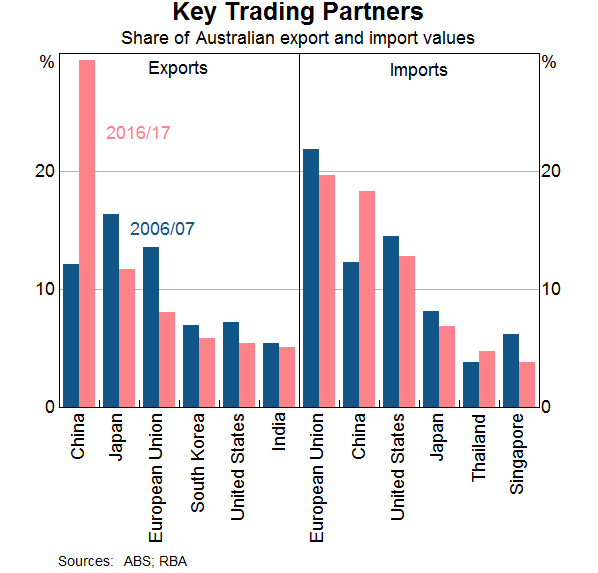
Our trade relationship with China is sometimes summarised as: we export resources to China and we import manufactured goods. It's understandable that people have used this shorthand: after all, exports of resources account for around two-thirds of our exports to China, with iron ore and coal alone accounting for 57 per cent.
But it would be a mistake to view the trade relationship solely in these terms. Our exports to China are much more diverse than this. In many individual categories, we now export more to China than any single other destination. So what happens in China is now directly relevant to a broad spectrum of Australian industries.
One area where this is obvious is in the export of services (Graph 2). Over the past decade, Australia's service exports to China have grown at an average annual rate of 15 per cent. As a result, our service exports to China are now greater than those to the United States and the United Kingdom combined.
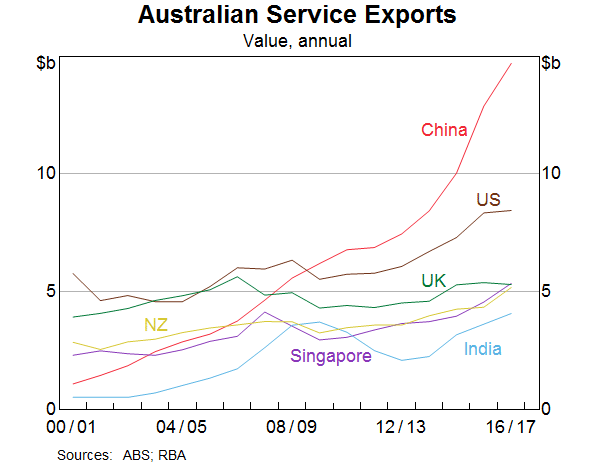
The growth has been particularly strong in the areas of tourism and education (Graph 3). There has also been strong growth in exports of business services.
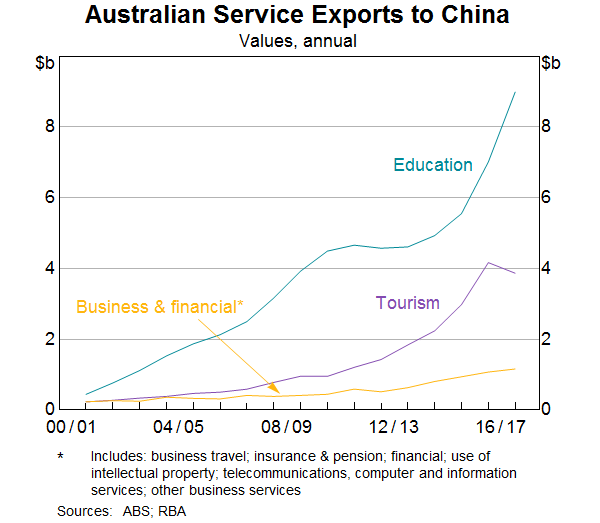
Last year there were 1.4 million visitors from China to Australia, up from around 400,000 a decade ago. In 2009, just four passenger airlines flew between China and Australia. Today, there are 15 airlines and last year there were more than 15,000 direct flights between our two countries. On average, Chinese visitors tend to stay longer in Australia and spend more money than other visitors. As a result, they now account for around 25 per cent of total visitor expenditure in Australia, a considerably larger share than any other country (Graph 4). This shift is having a significant effect on the tourism industry.
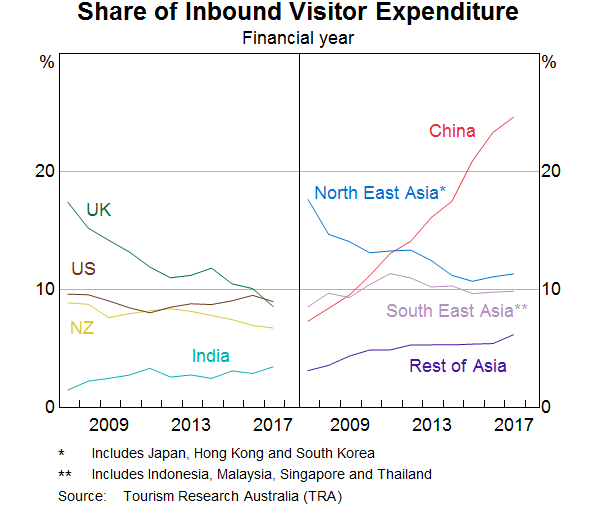
On the education front, there are currently around 200,000 Chinese students studying in Australia (Graph 5). Education exports to China now account for around one-third of Australia's total education exports, up from around one-fifth in 2009. Most of the students are studying at the tertiary level, but there has also been an increase in enrolments in Australian schools and vocational education programs. Even so, more than half of all Chinese tertiary enrolments in Australia are in the broad fields of management and commerce. For many educational institutions, foreign students, including those from China, have become an important source of fee revenue, with foreign students paying higher fees than domestic students.
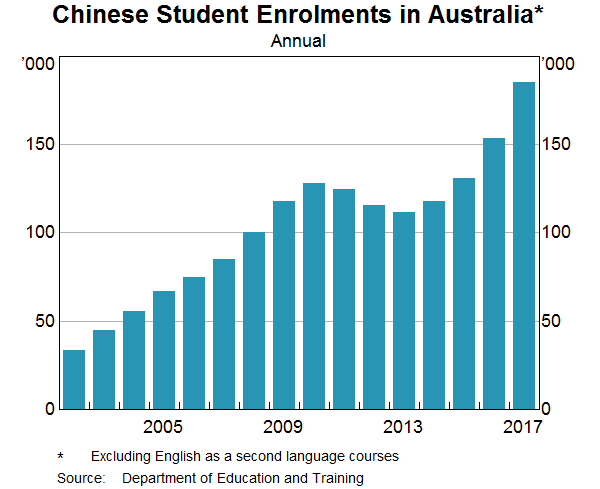
Moving beyond services, China has become the largest single export market for a range of Australia's manufactured food items (Graph 6). Exports of dairy products and alcoholic beverages have grown especially strongly, as have a range of other food and health-related products (of which vitamin sales are often remarked to be growing strongly). And more broadly, there has also been strong growth in exports to China of scientific instruments, pharmaceuticals and some telecommunication products.
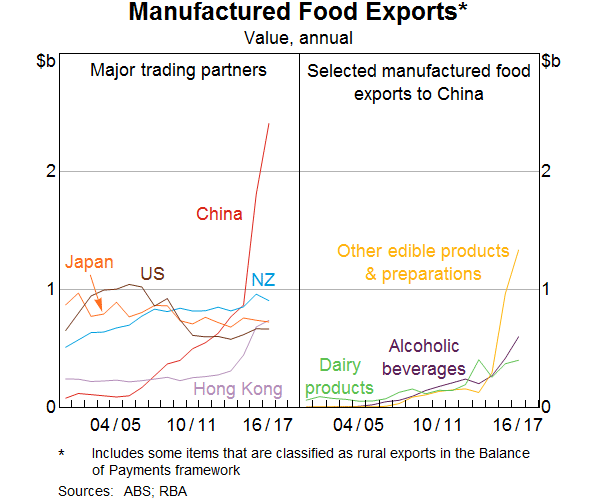
On the financial side, there has also been a broadening and deepening of the relationship, although it is not as developed as the trade side.
Currently, Chinese investment accounts for only a small share of the total stock of outstanding foreign investment in Australia – just 3 per cent. In contrast, the United States accounts for the largest share, at around 30 per cent.
Over time, though, there has been an increase in the amount of Chinese investment in Australia. There was a large wave of investment in the resources sector during the mining investment boom (Graph 7). Since this tailed off, there has been significant investment in other areas, including transport infrastructure and commercial property, although investment in commercial property has slowed recently, partly due to tighter Chinese restrictions in this area. The large Chinese banks now operating in Australia have helped facilitate this investment, and they are also providing banking services to a wide range of businesses in Australia.
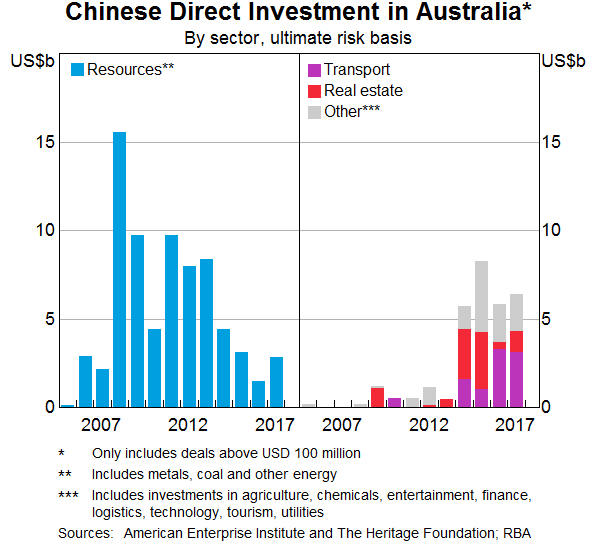
The RBA sees first-hand the stronger financial relationship between our two countries. Since 2012, the RBA has had a currency swap agreement with the People's Bank of China, with the goal of giving market participants in Australia confidence that renminbi (RMB) will be available for trade settlement and other payment obligations. The RBA also now holds 5 per cent of our foreign currency reserves in RMB. Furthermore, in 2014, the Bank of China was designated the official RMB clearing bank in Australia so as to better facilitate cross-border transactions in RMB. So there has been a lot happening on the financial side too.
One other dimension of the deepening relationship that I would like to draw your attention to relates to people. Over the past decade, the Chinese-born resident population in Australia has grown at an average rate of around 8 per cent per year (Graph 8). This builds on the long history of Chinese migration to Australia, which has contributed to the rich multicultural society we are today. According to the latest Census, people born in mainland China account for 2 per cent of Australia's population (around 510,000 people), and there are more than one million people who identify themselves as having some Chinese ancestry. It is not surprising, then, that Mandarin is now the second most commonly spoken language in Australian homes and Cantonese the fourth most common.
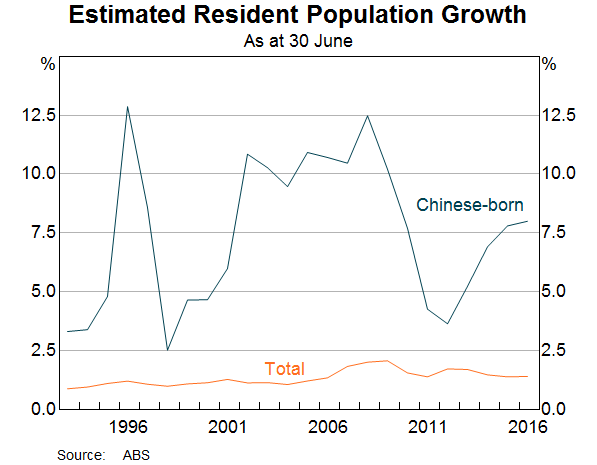
The overall picture, then, is one of a broader and deeper economic relationship with China. Of course, the same could be said for many other countries in our region. This means that China is important to us not just because of our substantial direct links, but also because of the indirect links through our other regional trading partners.
The deepening of our economic relationship with China has greatly benefited Australia. It has created new opportunities for us and significantly boosted our national income. It was also one of the factors that helped our economy through the global financial crisis. The deepening relationship has also benefited China in many ways. This means that both countries have a strong interest in managing this important relationship well. It is in our mutual interests to do this. Together, we can also be a strong voice for the importance of an open international trading system and for effective regional cooperation. We will, of course, have differences from time to time, but we will surely be better placed to deal with these if we understand one another well. Building strong connections across business, finance, politics, academia and the community more generally is important to deepening this understanding.
The Chinese Financial System
I would now like to turn to an issue that the RBA has focused on over recent times: that is the Chinese financial system. Understanding what is going on here is important. If a major economic shock were to originate from China over the coming years, its origin is most likely to be in the Chinese financial system. Not surprisingly, addressing this risk has become a priority of the Chinese authorities. We all have a strong interest in their efforts being successful.
I would first like to provide some background by briefly reviewing the development of the Chinese financial system. I will then discuss the risks, including those that have built up in the shadow banking sector. And then finally, I will turn to the recent measures taken by the Chinese authorities to address these risks.
Some Background
If we go back to just 1978 – which is not that long ago – China's financial system was very undeveloped; there were no equity, bond or funding markets, and most of the country's limited banking services were provided by just one bank – the People's Bank of China. It is fair to say that the financial system played only a rudimentary role in the Chinese economy.
Since then things have changed a lot.
In the initial reform years, post 1978, some of the functions of the People's Bank of China were carved out into state-owned commercial banks and later into specialised policy banks. It was during these years that the Chinese financial system developed some particular characteristics. Two are worth highlighting.
The first is that the system was very government centric. It was configured with the objective of channelling China's very high household savings into state-owned enterprises (SOEs) through government-owned banks. And it did this on very favourable terms to the SOEs. This was part of the strategy of fast-tracking industrial development and urbanisation.
The second characteristic was that there was very heavy financial repression – extensive capital controls, low deposit rates for savers, extensive restrictions on what banks could and could not do, a lack of alternative investment opportunities for savers, and limited access to finance for the fledgling private sector.
There was, of course, some progressive liberalisation and financial market innovation over time, but up until fairly recently the evolution was relatively modest. Things, though, began to change more noticeably around the time of the global financial crisis, and the result has been an extraordinarily large increase in debt since then.
This change was part of the effort by the Chinese authorities to boost internal demand, when exports fell during the financial crisis. As part of this effort, there was a very large lift in spending on infrastructure and construction. In other countries this might have been financed on the government's balance sheet, but in China it was financed mainly through the financial system. Achieving this required some lessening of the long-standing constraints on the supply of credit. The end result was a big increase in debt, with the ratio of debt to GDP rising significantly to its current level of around 260 per cent (Graph 9).
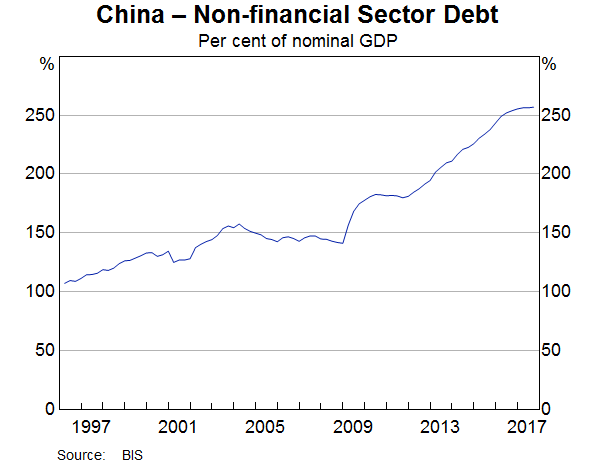
This increase in the debt ratio over the past decade has been larger than in any other major economy. This can be seen in this next chart, which shows the increase in this ratio since 2009 for a range of countries and the current level of that ratio (Graph 10). China clearly stands out. The stock of credit outstanding in China, relative to the size of the economy, is now unusually high by emerging market standards. And this ratio is already higher than in many advanced economies. So what has happened in China is quite different to the normal pattern.
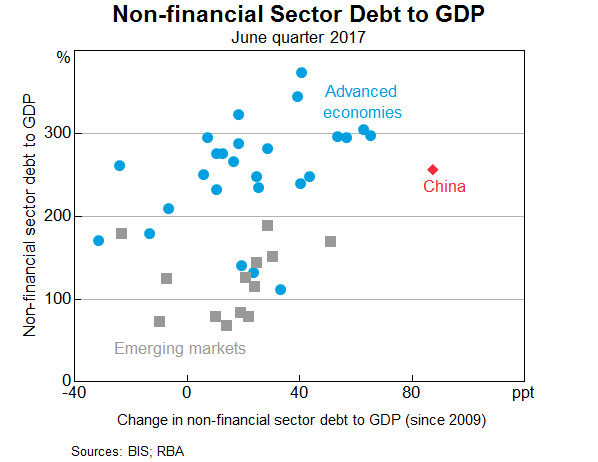
Over the period of rapid credit expansion, there was a series of reforms to modernise the Chinese financial system. Interest rate controls have been relaxed, although there is still ‘guidance’. A deposit insurance system has been introduced and the regulatory system has been strengthened. The capital markets are playing a more prominent role in the financial system. The large state-owned banks are now listed on stock exchanges in China and Hong Kong. It is also now somewhat easier for private firms to obtain equity finance. Controls on capital flows have also been relaxed somewhat over the last decade.
It is worth recognising that, taken together, these are significant changes. A decade ago, many outside observers were sceptical that the Chinese authorities would undertake reforms across many of these fronts. Yet they have made significant progress. Despite this progress, there is still much to be done before the Chinese financial systems looks like financial systems we see in the advanced economies.
One area where the Chinese financial system is moving towards a more modern form is in households' access to mortgage finance. Prior to the late 1990s, mortgages were essentially non-existent. But in recent years, households have progressively enjoyed increased access to finance, which has helped lift the share of consumption in national income. At the same time, as property prices have risen households have taken on larger mortgages. As a result, there has been a doubling of the ratio of household debt to GDP (Graph 11). Relative to other emerging market economies, household debt is no longer low in China, although it is much lower than in the advanced economies.
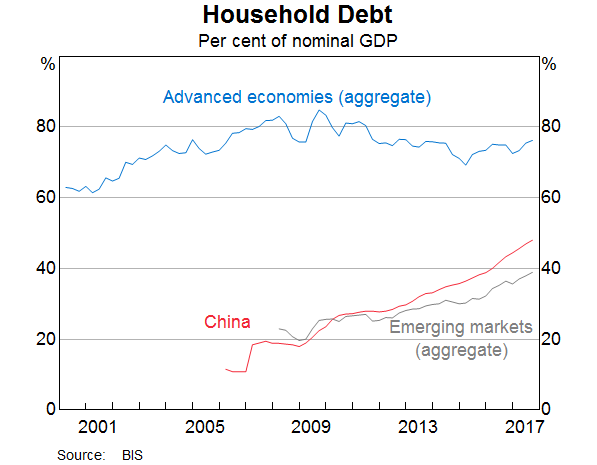
Putting all this together, the Chinese financial landscape and Chinese balance sheets look very different from a decade ago. At the same time, though, the financial system retains elements of its distinguishing characteristics: a heavy focus on state-owned banks providing credit to SOEs and relatively limited banking services for small to medium private businesses.
The Build-up of Risk
I would now like to turn to the risks that have built up in this system.
The historical cross-country experience is reasonably clear. The experience is that the build-up of financial risks like those seen in China is almost always followed by a marked slowdown in GDP growth or a financial crisis. It is important to point out that these outcomes are not inevitable and that China is able to learn from the experience of other countries, including Australia. Even so, it is understandable that concerns have been raised.
One of these concerns is that during the big run-up in debt, a lot of bad loans were made. Assessing the extent of this issue is made more complicated by the particular nature of the Chinese financial system.
On the one hand, the influence of the state and the incentives within financial institutions have almost surely distorted credit allocation and led to some poor lending decisions. For example, rapid credit expansion supported excess capacity developing in some heavy industries, with large loss-making enterprises kept afloat with additional borrowing. Provincial authorities also borrowed heavily through opaque off-balance sheet structures, so as to meet their growth targets. It is not unreasonable to suggest that many of these loans would have failed to meet credit standards in other banking systems. So these are reasons to be concerned about future problem loans.
On the other hand, though, the involvement of the state can make it easier to work through problems when they arise, and we have seen past examples of this in China. The state has the capacity, and the demonstrated willingness, to address financial problems when they occur. However, this has also tended to add to the moral hazard in the system. Whether this willingness to extend assistance to troubled borrowers and lenders will extend into the future is therefore difficult to tell. So it is complicated.
Another concern is the growth of the so-called ‘shadow banking’ system – that is, credit extended outside the formal banking system. The growth in non-bank financing is evident in this next graph, which again shows the ratio of debt to GDP, but broken down into the type of entities that are providing the credit (Graph 12). The picture is pretty clear. Most of the growth in debt has occurred outside the formal banking sector; non-bank financing now accounts for 45 per cent of total debt, up from 25 per cent a decade ago.
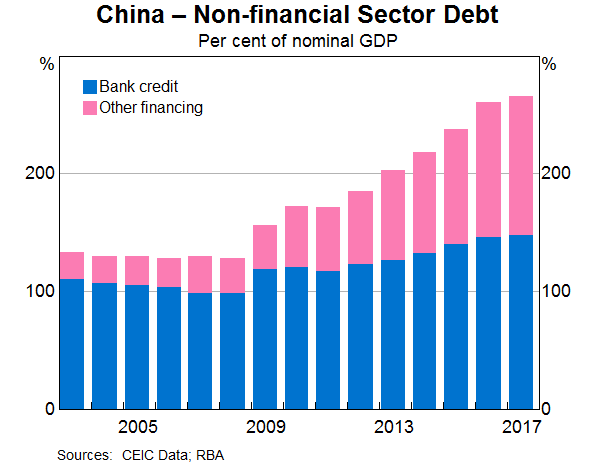
This growth of shadow banking reflects a few factors. Many entities in China, including private businesses and provincial governments, have had restricted access to credit through the large state-owned banks. As a result, they have sought finance outside the formal sector and they have been prepared to pay higher rates. On the other side of the equation, many investors have sought higher returns on their savings than those available through holding conventional deposits in the formal banking sector. Over time, thousands of smaller banks and other financial institutions emerged to connect those seeking to borrow outside the formal sector with those seeking higher returns. Many of these connections were very innovative and were often made through opaque structures, sometimes in off-balance sheet vehicles. Hence, the term, shadow financing.
It is useful to provide a couple of examples.
One is so-called ‘entrusted loans’ (Graph 13). These loans effectively involve one entity (say, a business) lending directly to another entity (say, another business), rather than the loan being intermediated through a bank balance sheet. Notwithstanding this, a bank would normally act as a trustee to the transaction and there can be a perceived promise by the bank to absorb any credit losses. So in some respects it is like a bank loan, but structured in a way that sidesteps some of the restrictions on lending and on interest rates paid to depositors. The popularity of these ‘entrusted’ loans increased greatly over the past decade.
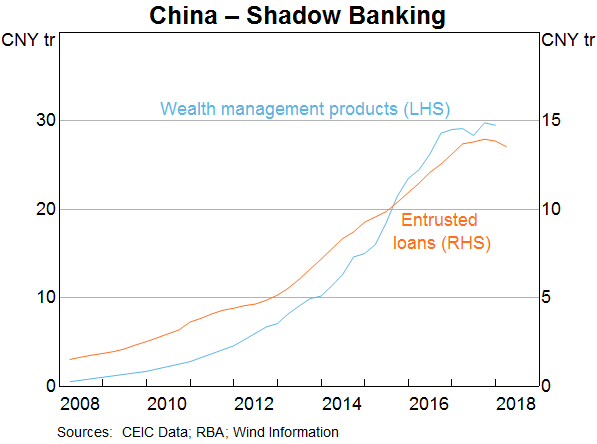
Another example of shadow financing is wealth management products. These products were sold in bank branches, again often with an implicit guarantee from the bank. They are effectively an investment vehicle, offering investors a fixed rate of return in excess of bank deposits, and investing in a range of assets such as loans and securities. Much of this financing operated in a very similar way to bank loans, but just in another legal form and packaged differently. The products again offered a way of sidestepping some of the regulations and helped underpin the rapid growth of debt. They offered banks an important new source of income to partly offset the decline in net interest margins that followed deposit and lending rate liberalisation.
The smaller banks have played an important role in the growth of shadow financing. This is evident in the rapid growth of their claims on non-bank financial institutions (Graph 14). There are now over 3,500 smaller institutions, with many of them channelling money to the shadow banking activities, including through trust companies in exchange for ‘participation’ or ‘beneficiary’ rights. They have been more active participants in the shadow banking industry because their thinner deposit base did not allow for a big increase in traditional loans.
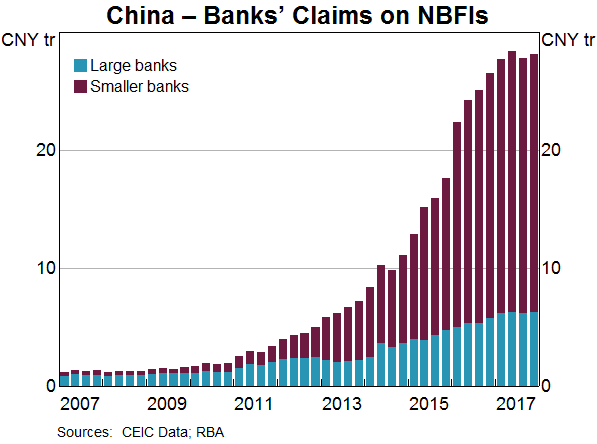
So it is a complex web of interconnections that has been built. New institutions have also emerged and a lot of this has been in the shadows, outside of the regulatory net. It's worth recalling that we saw a similar process here in Australia in the 1970s. As some of the regulations were eased here and more things became permissible, we too saw new institutions emerge – just has been the case in China – to sidestep the regulations that remained. In our case, this did not end well! This helps explain why we are watching things in China so carefully.
The complex web that has developed in China is characterised by opaque risk transfers, implicit guarantees and complex connections. To the extent that experience elsewhere in the world is any guide, it is difficult to escape the conclusion that this complex web in a highly indebted economy is a risky situation.
The Policy Response
Dealing with this risk has become a key priority for the Chinese authorities. Reflecting this, at a recent policy meeting convened by President Xi Jinping, the leadership called for a gradual reduction in the debt-to-GDP ratio. This marked a significant change from earlier statements from officials suggesting the target was only to slow the growth in leverage.
The authorities are clearly taking the issue seriously and they are making progress. The policy response, to date, has had a number of related elements.
One is to subject shadow banking, including asset management activities, to more stringent oversight. The new rules include stricter leverage caps for investment products and restrictions on investment in certain types of non-standard credit assets.
Another element of the response has been stronger guidance to banks regarding their exposures to non-bank financial institutions. As part of this, the People's Bank of China recently widened the scope of its quarterly Macro-Prudential Assessment (MPA) of banks to better assess and address shadow banking risks. The MPA now includes consideration of the risks to banks from exposures through off-balance sheet vehicles, including wealth management products.
There have also been efforts to address the significant risks in local government financing, including by increasing transparency. As part of this effort, local governments have been participating in a ‘debt swap’ program, where off-balance sheet debt is swapped for local government bonds. The Ministry of Finance has also tightened off-balance sheet financing channels for local governments and their related entities. And at the National Financial Work Conference last year, it was suggested that officials would have ‘lifelong accountability’ for debt balances. This was designed to reduce incentives to pursue higher growth by increasing debt.
Finally, the regulatory structure has been strengthened. In particular, a Financial Stability and Development Committee was established in June last year, with strong political backing. The committee is responsible for coordinating regulatory reforms and considering financial stability risks. The banking and insurance regulators have also been merged, partly to address the concerns about regulatory arbitrage.
These various measures provide a strong signal that the Chinese authorities are serious about addressing the vulnerabilities. Consistent with this, the lower economic growth target for 2018 of 6.5 per cent suggests some tolerance for a gradual slowing in growth. This is a positive development, given that over recent years there was a concern that the authorities would fail to address the financial risks for fear of damaging the economy in the short term.
While it is still early days, the evidence to date is that the various measures are having an effect (Graph 15). Growth in credit outstanding has slowed to be around the same pace as that in nominal GDP. This is the first time that this has been the case for some years. There has also been a sharp slowing in growth in shadow financing, as reflected in banks' claims on non-bank financial institutions.
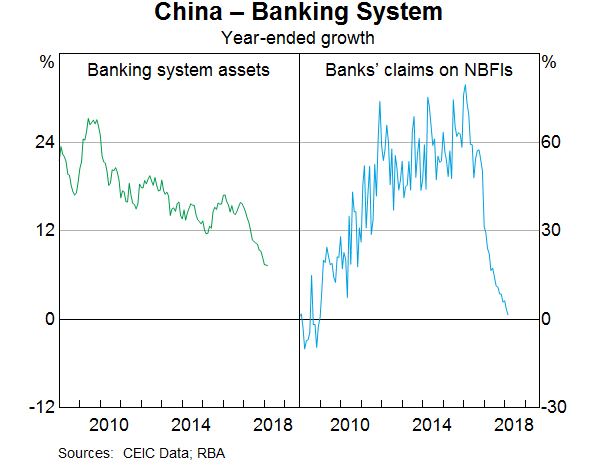
This tightening on the financial side, together with measures to reduce pollution, has led to some slowing in economic growth in China, although growth remains solid (Graph 16). The slowing is evident in fixed asset investment, although overall activity continues to be supported by strong conditions in the property sector and rapid growth in infrastructure investment. In addition, a number of structural developments are providing some offset to the tightening in credit conditions. In recent years, the services sector has become the strongest contributor to growth, and consumption has been resilient. The government is also promoting industrial upgrading, including through its ‘Made in China 2025’ policy to make China a global leader in numerous high-tech sectors. So there are a lot of moving parts at the moment.
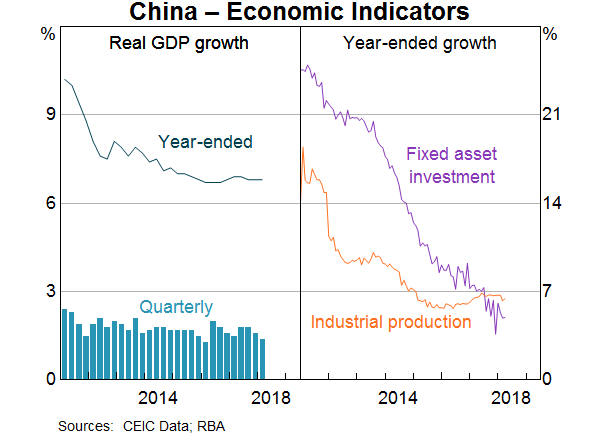
It is too early to tell whether the authorities will be successful in managing the transition from a growth model heavily dependent upon the accumulation of debt to one where credit is less central. It is a very significant task. The experience of other countries suggests caution and, elsewhere, there have been serious accidents along the way. The Chinese authorities can learn from this experience and are now moving in the right direction.
China's challenge is made more complicated by the dual nature of the task to bring down debt levels while also reconfiguring the financial system so as to better meet the needs of the people. There are pressing needs to make financing more widely available to small and medium enterprises, to strengthen the pension system to bolster retirement incomes, to increase transparency and reduce implicit guarantees associated with local government and SOE borrowing. So there is still a lot to be done. At the RBA we are watching this process carefully.
We know from our own experience here in Australia that the journey of financial reform can be a bumpy one. We also know that this journey is well worth undertaking, and leaves the financial system stronger, more efficient and better able to serve the needs of the real economy. I look forward to the day when China will be able to reach the same conclusion about its journey.
Finally, it is worth repeating that Australia has a strong interest in this being the case. A stable and robust financial system in China is clearly in Australia's interest. So too is a prosperous China as part of a rules-based international system. As the economic relationship between our two countries broadens and deepens, developments in China are having a material impact on more and more Australian industries: it is more than just about resources. It is therefore important that we have a thorough understanding of one another. We all have a role to play in helping build that understanding.
Thank you and I would be happy to answer your questions.
Endnote
I would like to thank Adam Cagliarini, Brad Jones, Kate McLoughlin, Ivan Roberts and Miles Waring for assistance in the preparation of this talk. [*]
